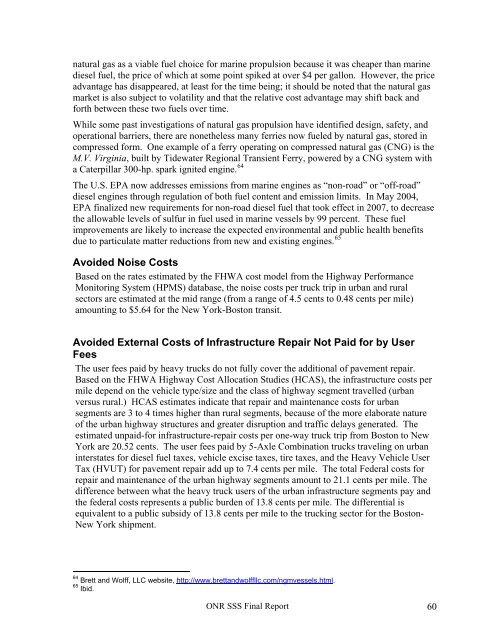natural gas as a viable fuel choice for marine propulsion because it was cheaper than marinediesel fuel, the price <strong>of</strong> which at some point spiked at over $4 per gallon. However, the priceadvantage has disappeared, at least for the time being; it should be noted that the natural gasmarket is also subject to volatility and that the relative cost advantage may shift back andforth between these two fuels over time.While some past investigations <strong>of</strong> natural gas propulsion have identified design, safety, andoperational barriers, there are nonetheless many ferries now fueled by natural gas, stored incompressed form. One example <strong>of</strong> a ferry operating on compressed natural gas (CNG) is theM.V. Virginia, built by Tidewater Regional Transient Ferry, powered by a CNG system witha Caterpillar 300-hp. spark ignited engine. 64The U.S. EPA now addresses emissions from marine engines as “non-road” or “<strong>of</strong>f-road”diesel engines through regulation <strong>of</strong> both fuel content and emission limits. In May 2004,EPA finalized new requirements for non-road diesel fuel that took effect in 2007, to decreasethe allowable levels <strong>of</strong> sulfur in fuel used in marine vessels by 99 percent. These fuelimprovements are likely to increase the expected environmental and public health benefitsdue to particulate matter reductions from new and existing engines. 65Avoided Noise CostsBased on the rates estimated by the FHWA cost model from the Highway PerformanceMonitoring System (HPMS) database, the noise costs per truck trip in urban and ruralsectors are estimated at the mid range (from a range <strong>of</strong> 4.5 cents to 0.48 cents per mile)amounting to $5.64 for the New York-Boston transit.Avoided External Costs <strong>of</strong> Infrastructure Repair Not Paid for by UserFeesThe user fees paid by heavy trucks do not fully cover the additional <strong>of</strong> pavement repair.Based on the FHWA Highway Cost Allocation Studies (HCAS), the infrastructure costs permile depend on the vehicle type/size and the class <strong>of</strong> highway segment travelled (urbanversus rural.) HCAS estimates indicate that repair and maintenance costs for urbansegments are 3 to 4 times higher than rural segments, because <strong>of</strong> the more elaborate nature<strong>of</strong> the urban highway structures and greater disruption and traffic delays generated. Theestimated unpaid-for infrastructure-repair costs per one-way truck trip from Boston to NewYork are 20.52 cents. The user fees paid by 5-Axle Combination trucks traveling on urbaninterstates for diesel fuel taxes, vehicle excise taxes, tire taxes, and the Heavy Vehicle UserTax (HVUT) for pavement repair add up to 7.4 cents per mile. The total Federal costs forrepair and maintenance <strong>of</strong> the urban highway segments amount to 21.1 cents per mile. Thedifference between what the heavy truck users <strong>of</strong> the urban infrastructure segments pay andthe federal costs represents a public burden <strong>of</strong> 13.8 cents per mile. The differential isequivalent to a public subsidy <strong>of</strong> 13.8 cents per mile to the trucking sector for the Boston-New York shipment.64 Brett and Wolff, LLC website, http://www.brettandwolffllc.com/ngmvessels.html.65 Ibid.ONR SSS Final Report 60
5-4 Estimating Reduced Costs <strong>of</strong> Meeting Future Highway CapacityNeedsBetter utilization <strong>of</strong> the vast capacity <strong>of</strong> the nation’s coastal and inland waterways fordomestic shipping is tantamount to significantly reducing the nation’s future needs forhighway capacity expansion. Several studies reviewed in this section have estimated thecosts <strong>of</strong> expanding the highway network, estimated to cost between $103 billion to $155billion per year in the several decades.Resources needed to pay for highway capacity expansion are becoming increasingly scarce,particularly with rising highway capacity constraints on several key arteries in coastal areas,most notably the I-5 (Pacific), I-95 (Atlantic), and I-10 (Gulf) corridors. Urban planners inlarge cities such as New York and Los Angeles question whether building new infrastructurewill solve these capacity constraints, reasoning that both rail and highway networks servingthe nation’s coastlines are at or beyond capacity and their expansion could be achieved onlyat exorbitant costs. 66In 2008, the Society <strong>of</strong> Civil Engineers estimated that improving the nation’s surfacetransportation infrastructure would require $155.5 billion annually. The IGMS reportconcluded that the total price tag to shore up this failing system would reach over a trilliondollars and that “we cannot pave our way out <strong>of</strong> this challenge.” 67A 2007 report by the <strong>National</strong> Cooperative Highway <strong>Research</strong> Program (NCHRP) hasreported that to meet the performance needs <strong>of</strong> the existing interstate highway system, anadditional 173,000 lane miles <strong>of</strong> capacity will need to be added to the existing 210,000 lanemiles <strong>of</strong> the Interstate System. Meeting these capacity-needs requires a total expenditure <strong>of</strong>$103 billion per year over the next 30 years, with a 30-year total <strong>of</strong> $3.1 trillion. Two majorcomponents on the NCHRP highway improvement study are the Freight Logistics NetworkImprovement Program and the Metropolitan Mobility Program. Meeting the FreightLogistics Network’s improvement needs would require building additional 68,600 miles <strong>of</strong>capacity, at annual costs <strong>of</strong> $27 billion, or $835 million over the next 30 years. Meeting theMetropolitan Mobility Program would require adding 73,000 lane miles <strong>of</strong> capacity, at theannual cost <strong>of</strong> $71 billion, with outlays <strong>of</strong> $2.2 trillion over the 30-year period. 68 Adequateresources have not been available to pay for these freight and metropolitan mobilityprograms, both closely related to the nation’s needs for expanding the critical freightinfrastructure. 69 A targeted SSS program geared to utilizing the existing marinetransportation capacity for domestic shipping would be an efficient solution to this resourceshortfall.66 Institute for Global Maritime Studies in cooperation with the Fletcher School <strong>of</strong> Law and Diplomacy, TuftsUniversity, “America’s Deep Blue Highway: How Coastal Shipping Could Reduce Traffic Congestion, LowerPollution, and Bolster <strong>National</strong> Security,” September 2008.67 Institute for Global Maritime Studies in cooperation with the Fletcher School <strong>of</strong> Law and Diplomacy, TuftsUniversity, “America’s Deep Blue Highway: How Coastal Shipping Could Reduce Traffic Congestion, LowerPollution, and Bolster <strong>National</strong> Security,” September 2008.68 <strong>National</strong> Cooperative Highway <strong>Research</strong> Program(NCHRP), Future Options for the <strong>National</strong> System <strong>of</strong>Interstate and Defense Highways, Task 10 Final Report, Prepared by PB Consultant, Inc. and CambridgeSystematics, Inc., May 2007.69 FHWA, Estimated Cost <strong>of</strong> Freight Involved in Highway Bottlenecks – Final Report, Nov. 12, 2008.ONR SSS Final Report 61
















